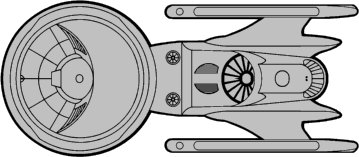Scylla Class
Posted: Wed Aug 19, 2020 2:21 pm



The Scylla Class Scout, from Stardate Magazine.
Brdg- 2
Aux- 2
Emer- 1
Prb- 1
Specsen- 3
Lab- 5
Tran- 2
Trac- 2
Hull- 10x F, 5x A
Cargo- 3
Hold- 3
Shtl- 2
Warp- 2x 10
Imp- 4
AWR- 3
Btty- 3
Ph-1- 3x LS, 3x RS
Phtn- 3x FA
Drn-GX- 1
Sensor- 6-5-4-3-1-0
Scanner- 0-0-1-3-5-9
Damcon- 6-4-4-2-2-0
Excdam- 6
Move Cost- .66
Turn Mode- D
Breakdown- 5-6
Crew Units- 18
Boarding Parties- 4
Shields- 24/24/24/24/24/24
BPV = 130
History-
When the radically-new design for the Excelsior class battleship was proposed to Star Fleet, there was no doubt in Procurement about the entire design. Not only were the proposed trans-warp engines an unknown quantity, but the controls and engineering spaces, the wiring and the layout of the vessel itself were very new. Star Fleet was unwilling to commit the funds to construction until some of the uncertainty had been dispelled.
An engineering "testbed" vehicle, incorporating as much of the Excelsior's new features--minus the engines--was therefore proposed for full testing. Only a quarter of the battleship's displacement, it would nonetheless simulate all the calculated stresses and include all the intended equipment, and it could be constructed in less than a year. Construction was at the Sol IV shipyards, under the code designation 'Scylla'. (Rumor says that Project 'Charybdis' was the trans-warp development program, but there is no proof.)
The new design proved exceptionally sound and very serviceable, and did everything the engineers wished, including showing some minor faults and design errors that could have shown up on the battleship. All were found and corrected, and a few that could have crept in when the full-size Excelsior was constructed. The 'Scylla' project, in fact, proved so successful that Star Fleet determined that the testbed starship could be modified into a serving vessel and added to the lists. All it would take was the addition of armament and the removal of the engineering instruments.
The Scylla class of scouts posed a unique problem in defining a mission they could carry out. They were not natural warships. Conventional design philosophy for such ships is to set the weapons package first and then build a ship to carry it. The Scylla was not intended to be armed; the weapons added to it (two banks of adequate phasers and two photon torpedo tubes) make it a creditable but not formidable threat.
Its shipkeeping qualities, on the other hand, are above-average, and its sizeable cargo capacity, combined with its overall sound design, make the Scylla a very reliable craft for frontier patrol and remote base replenishment. In this mission capacity the Scylla class performs like a normal cruiser, though its small size and only normal endurance restrict its operational radius. Star Fleet is not troubled by this; they had the design in hand already, and there is always a need for additional ships of any good size on the frontier.
Because the design is so closely related to that of the Excelsior, Star Fleet has restricted the operation of the class to Quadrants I and II, far from the prying Romulan, Klingon, and Orion eyes.